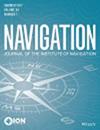A Flexible GNSS Spoofer Localization System: Spoofing Discrimination and Localization Method
IF 2
3区 地球科学
Q1 ENGINEERING, AEROSPACE
引用次数: 2
Abstract
Global navigation satellite systems (GNSS) are vulnerable to spoofing attacks. To shut down a spoofer, it is necessary to locate the spoofer first. Many spoofer localization systems use long cables for the synchronization of multiple receiv ers. However, a flexible spoofer localization system free from cables is sometimes essential so the receivers can move freely and are flexible to deploy. This paper solves two major problems in developing such a system: spoofing discrimina tion without requiring synchronization and having an effective method using asynchronous raw measurements with no other assistance. First, this paper pro poses to use the extended pseudorange double-difference method to discrimi nate spoofing signals. The performance is then analyzed and the effectiveness is verified. Then, a quasi-synchronization spoofer localization method (QSSL) is proposed, and it is verified that its localization performance can attain the Cramer-Rao lower bound. Above all, a field experiment demonstrates the effec tiveness of the proposed methods and the feasibility of such system.一种灵活的GNSS欺骗定位系统:欺骗识别与定位方法
全球卫星导航系统(GNSS)容易受到欺骗攻击。要关闭欺骗器,必须首先定位欺骗器。许多欺骗定位系统使用长电缆来实现多个接收机的同步。然而,一个灵活的欺骗定位系统,不需要电缆,有时是必要的,这样接收器可以自由移动,灵活部署。本文解决了该系统开发中的两个主要问题:不需要同步的欺骗识别,以及在没有其他辅助的情况下使用异步原始测量的有效方法。首先,本文提出了利用扩展伪距双差分方法来判别欺骗信号。然后对其性能进行了分析,验证了其有效性。然后,提出了一种准同步欺骗子定位方法(QSSL),并验证了其定位性能能够达到Cramer-Rao下界。最后,通过现场试验验证了所提方法的有效性和系统的可行性。
本文章由计算机程序翻译,如有差异,请以英文原文为准。
求助全文
约1分钟内获得全文
求助全文
来源期刊

Navigation-Journal of the Institute of Navigation
ENGINEERING, AEROSPACE-REMOTE SENSING
CiteScore
5.60
自引率
13.60%
发文量
31
期刊介绍:
NAVIGATION is a quarterly journal published by The Institute of Navigation. The journal publishes original, peer-reviewed articles on all areas related to the science, engineering and art of Positioning, Navigation and Timing (PNT) covering land (including indoor use), sea, air and space applications. PNT technologies of interest encompass navigation satellite systems (both global and regional), inertial navigation, electro-optical systems including LiDAR and imaging sensors, and radio-frequency ranging and timing systems, including those using signals of opportunity from communication systems and other non-traditional PNT sources. Articles about PNT algorithms and methods, such as for error characterization and mitigation, integrity analysis, PNT signal processing and multi-sensor integration, are welcome. The journal also accepts articles on non-traditional applications of PNT systems, including remote sensing of the Earth’s surface or atmosphere, as well as selected historical and survey articles.
 求助内容:
求助内容: 应助结果提醒方式:
应助结果提醒方式:


